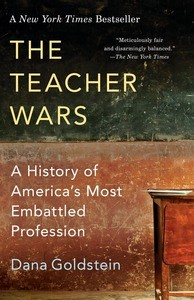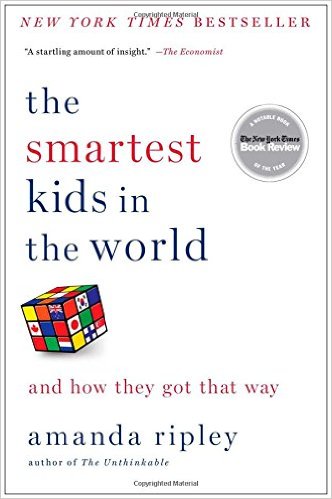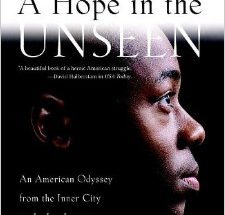
I thought of the Biblical story of Adam and Eve and the apple as I read The Teacher Wars: A History of America’s Most Embattled Profession by Dana Goldstein. The fruit, which was given to teachers to show appreciation and is symbolic of the profession, had the power to change my view of teaching once I read her book. Educators are expected to avoid controversy, accept modest pay, provide the springboard for economic advancement, fix many of society’s problems and produce well-educated, well-adjusted and knowledgeable young people. These are quixotic expectations.
Goldstein delves deep into pivotal moments in education history, introduces important historical figures and shows that there are few original ideas when it comes to education reform. However, as the daughter and grand-daughter of teachers, I wondered why Goldstein was unwilling to concede that some of the ideas of reformers benefitted students and teachers, and that unions need outside organizations to pressure them to adapt to the times.
She frames her book by opening with a chapter on Massachusetts education reformer Horace Mann and an early advocate for women teachers, Catherine Beecher. Previously, the teaching was profession that was predominately male. When Beecher and Horace Mann promoted the job as “missionary work,” they argued that it was best suited for single women, who would be paid less than men. The strategy convinced state lawmakers to invest more money in schools, but it unknowingly laid the groundwork for future battles between the government and future teacher unions.
Goldstein drew on the philosophical debate between 20th century African-African intellectuals W.E.B. DuBois and Booker T. Washington to describe the different roles of teacher training. Should the purpose of education be to move a select group of young people into higher education, as DuBois argued? Or, should its purpose be to train students in practical knowledge for future employment, as Washington believed? There is still no definitive answer to the question. The unresolved debate also symbolized the conflict inside and outside of the profession of what we want our teachers to be and the argument cut across racial lines.
The book also introduces readers to key players in shaping the teacher unions, such as former teacher turned full-time union activist Al Shanker. Through him, Goldstein’s reporting illustrates the tightrope teachers walk between enlisting community involvement, addressing problems within its union, and being perceived as the enemy to the community. In 1967, Black activists in the Brooklyn neighborhood of Ocean Hill-Brownsville believed the union and the majority of the white teachers in their community perpetuated institutionalized racism and stifled the potential of black students. The school board got rid of some white teachers and principals, and replaced them with ones they found less offensive. In response, Shanker organized several strikes, within the district and citywide. The union eventually won the dispute, but left lingering questions. How do you deal with racism within the teaching profession? Teachers want community involvement, but what role do activists play?
Goldstein also reveals there are no new ideas in teaching. Teach for America, a national teacher corps founded in 1989 where recent college graduates committed two years to teach in underserved public schools around the country, mirrors the federally funded initiative National Teachers Corps in the 1960s. Former Peace Corps volunteers and graduates of prestigious colleges would teach at struggling schools in poor communities. Like Teach for America, the program highlighted the tension between longtime educators and newcomers in places such as Cardozo High School in Washington, D.C. “Resentments bubbled up between interns and veteran teachers, who had few opportunities for formal interaction. The Cardozo Project received federal funding, which meant the interns had… school supplies veterans often lacked. Interns were young experienced, and mostly white, while Cardarzo’s veterans were generally middle-aged and black,” wrote Goldstein.
In her epilogue, Goldstein offers her ideas on how to improve the profession and the quality of public schools. Some of her suggestions include: Return standardized tests to its original purpose as a diagnostic tool; Keep teachers engaged and offer them “exciting and varied offer the long term which includes opportunities to lead adults, not just children;” End LIFO (last in, first out), the practice of downsizing the most recently hired teacher first, regardless of quality. She advocates instead that the worst teachers be fired first. However, they should be first be given a year or two to improve and an arbitrator or a peer review board makes the final decision.
Her absence of any suggestions for reformers or how reformers and teachers might work together hinted that she is not in favor of their efforts. Goldstein accurately writes that teachers unions need to adapt to the times, but she fails to fully acknowledge that strong outside voices–everyday citizens who are not part of the city–state or Federal government, help drive that change.
Goldstein did an excellent job of reporting the facts about the milestones of teaching history and letting the reader decide how they should be interpreted. Like taking a bite of the Biblical apple, my views of the teaching profession changed after reading her book. I finished the 274 pages with a broader outlook of the industry and questioned my own expectations of them. With good teachers and strong schools, students can achieve great things. However, believing that teachers can correct many of society’s ills is like life before the apple.



